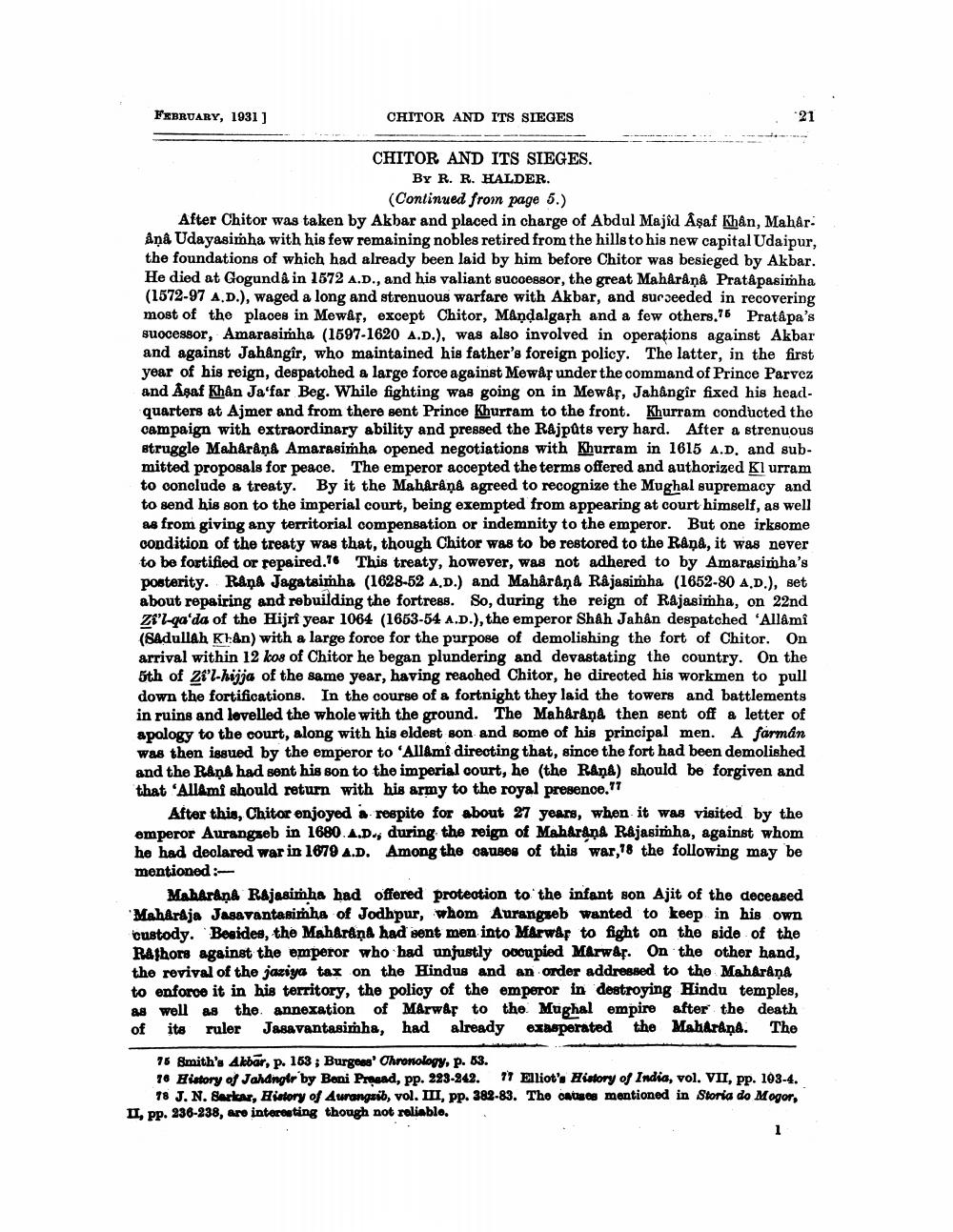________________
FEBRUARY, 1931 ]
CHITOR AND ITS SIEGES
21
CHITOR AND ITS SIEGES.
By R. R. HALDER.
(Continued from page 5.) After Chitor was taken by Akbar and placed in charge of Abdul Majid Aşaf Khan, Mahar. Ana Udayasimha with his few remaining nobles retired from the hills to his new capital Udaipur, the foundations of which had already been laid by him before Chitor was besieged by Akbar. He died at Gogunda in 1572 A.D., and his valiant sucoessor, the great Maharana Prat&pasimha (1572-97 A.D.), waged a long and strenuous warfare with Akbar, and surseeded in recovering most of the places in Mewar, except Chitor, Mandalgașh and a few others.76 Pratâpa's suocessor, Amarasimha (1697-1620 A.D.), was also involved in operations against Akbar and against Jahangir, who maintained his father's foreign policy. The latter, in the first year of his reign, despatched a large force against Mewår under the command of Prince Parvez and Aşaf Khan Ja'far Beg. While fighting was going on in Mewar, Jahangir fixed his headquarters at Ajmer and from there sent Prince Khurram to the front. Khurram conducted the campaign with extraordinary ability and pressed the Rajpats very hard. After a strenuous struggle Mahåråņå Amarasimha opened negotiations with Khurram in 1615 A.D. and submitted proposals for peace. The emperor accepted the terms offered and authorized Kl urram to conclude a treaty. By it the Maharana agreed to recognize the Mughal supremacy and to send his son to the imperial court, being exempted from appearing at court himself, as well as from giving any territorial compensation or indemnity to the emperor. But one irksome condition of the treaty was that, though Chitor was to be restored to the Raņa, it was never to be fortified or repaired.76 This treaty, however, was not adhered to by Amarasimha's posterity. Raņ& Jagatsimha (1628-52 A.D.) and Mahårána Råjasimha (1652-80 A.D.), set about repairing and rebuilding the fortress. So, during the reign of Rajasimha, on 22nd Zi'l-qa'da of the Hijri year 1064 (1663-54 A.D.), the emperor Shah Jahan despatched 'Allamî (Sadullah Khan) with a large force for the purpose of demolishing the fort of Chitor. On arrival within 12 kos of Chitor he began plundering and devastating the country. On the 5th of Zi'l-hijja of the same year, having reached Chitor, he directed his workmen to pull down the fortifications. In the course of a fortnight they laid the towers and battlements in ruins and lovelled the whole with the ground. The Maharana then sent off a letter of apology to the court, along with his eldest son and some of his principal men. A farmán was then issued by the emperor to 'AllAmi directing that, since the fort had been demolished and the Raņå had sent his son to the imperial court, he (the Rana) should be forgiven and that 'AllAmi should return with his army to the royal presence.17
After this, Chitor enjoyed å respite for about 27 years, when it was visited by the emperor Aurangzeb in 1680. A.D., during the reign of Maharana Rajasimha, against whom he had deolared war in 1879 A.D. Among the causes of this war, 18 the following may be mentioned
Maharan Rajasimha had offered proteotion to the infant son Ajit of the deceased Mahårája Jasavantasimha of Jodhpur, whom Aurangzeb wanted to keep in his own custody. Besides, the Maharana had sent men into Marwar to fight on the side of the Rashore against the emperor who had unjustly occupied Marw&r. On the other hand, the revival of the jaziya tax on the Hindus and an order addressed to the Mahârând to enforoe it in his territory, the policy of the emperor in destroying Hindu temples, as well as the annexation of Marwer to the Mughal empire after the death of its ruler Jasavantasimha, had already exasperated the Maharana. The
76 Smith's Akbar, p. 163; Burgess' Chronology, p. 63. 76 History of Jahangir by Boni Prosad, pp. 223-242. 11 Elliot's History of India, vol. VII, pp. 103-4.
78 J. N. Sarkar, History of Aurangaib, vol. III, pp. 382-83. The CAUSCE mentioned in Storia do Mogor, II, pp. 236-238, are interesting though not reliable,




